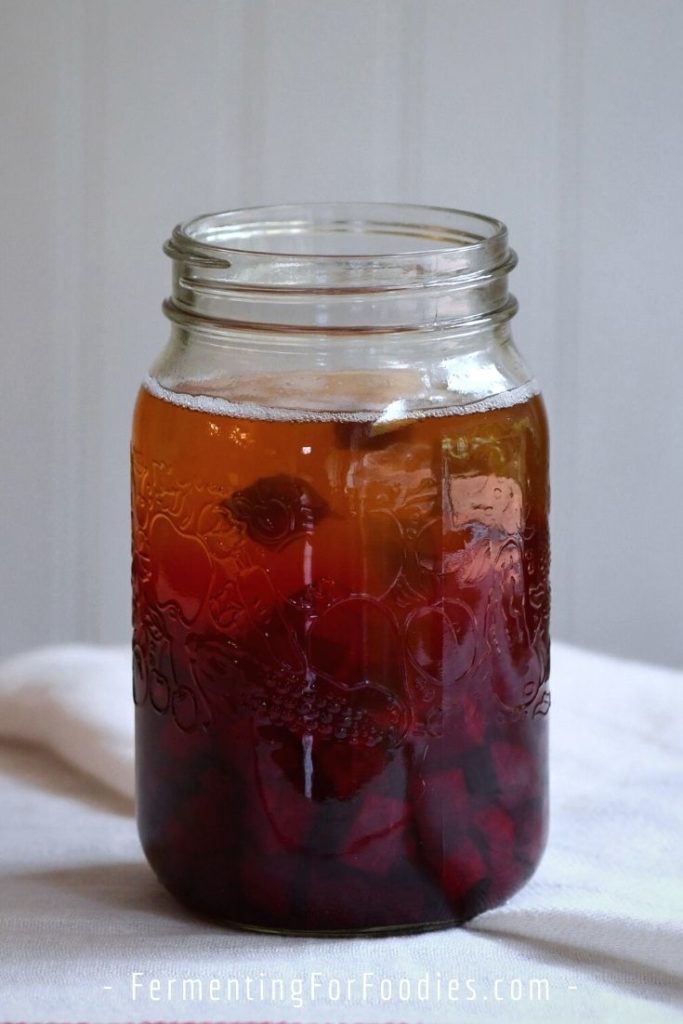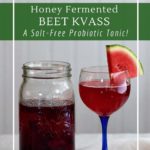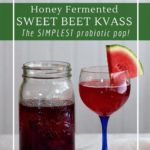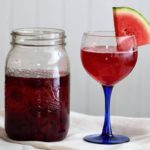Sweet beet kvass is a lightly sparkling and refreshing beverage. Like mead, it relies on the natural fermentation properties of raw honey for a delicious and probiotic drink.

There are many different types of kvass. In my husband’s Russian cookbooks there are recipes for bread kvass, cucumber kvass, and beet kvass. I think kvass might mean fermented beverage, though some of the recipes are for acidic soups.
I created this recipe as a less-salty alternative to the traditional beet kvass, a tonic-style beverage.
Probiotic Soda Pop
There are a lot of different probiotic beverages that provide a healthy alternative to soda pop. They are sweet, sparkly, and refreshing on a hot sunny day. Some beverages, like kombucha, require continuous brewing.
The ginger and turmeric bug take about a week to catch then brew.
This simple sweet beet kvass is my favorite soda pop alternative.
- Since it is made from honey, it is refined sugar-free. And with only 2 tablespoons of honey, it’s really not very sweet.
- Full of the vitamin and mineral goodness of beets.
- It’s made from scratch each time, so you only need to brew what you want to drink.
- And it’s a beautiful shade of pink!
Adding Flavors
Sweet beet kvass is perfect for all sorts of different sweet-fermented flavors. Here are a few options that I really enjoy:
- Vegetable cocktail: Use a mix of beets and carrots for a sweet vegetable mix.
- Citrus: Add the zest of an orange, lemon or lime for a bit of a citrus flavor. I don’t recommend adding the whole fruit as citrus doesn’t always ferment nicely.
- Orchard fruit: Add in sliced peaches, pears, apples or plums. You can easily add in upto 1 cup of sliced fruit for flavor. However, don’t descrease the beet, as they provide some of the necessary sugars to feed the ferment.
- Mint: Add a few sprigs of fresh mint for a refreshing drink.
How to make carbonated sweet beet kvass
This is a lightly sparkling beverage. To increase the bubbles, you will need to bottle the kvass and prime it with a bit more sugar.
Here’s how to get your sweet kvass to bubble.
- Strain the liquid into a plastic pop bottle or a swing-top beer bottle. Avoid decorative bottles as they won’t be able to handle the buildup of carbonation.
- Add 1 tsp of sugar to the bottle to prime the carbonation. Cap it, and swirl to dissolve the sugar.
- Leave the bottle out on the counter for 1-3 more days, until it is carbonated. If you’re using a flip-top bottle, you will need to test carbonation by popping the lid.
- When it’s carbonated, store it in the fridge, and enjoy within 2 weeks.

Sweet Beet Kvass
Sweet beet kvass is a slightly sparkly and refreshing beverage. Like mead, it relies on the natural fermentation of raw honey for a delicious alternative to pop.
- Prep Time: 10 minutes
- Total Time: 10 minutes
- Yield: 2 cups 1x
- Category: Beverages
- Method: Fermented
- Cuisine: Probiotic
- Diet: Vegetarian
Ingredients
- 2 1/2 cups water (chlorine-free)
- 2 Tbsp raw honey (see notes)
- 1 medium-sized beet (or 2 smaller beets)
- Additional flavors (see section above for suggestions)
Instructions
- Mix the water and honey in the bottom of a 1-quart (1 L) jar.
- Scrub the beet. Remove the top and tail, but don’t peel the beet. Chop the beet up into small cubes. You need at least 1 cup of beet cubes.
- Add the beet cubes to the jar. Cap the jar with a lid that will allow gas to escape as it ferments (see notes).
- Place the jar somewhere dark to ferment for 2-3 days. (A kitchen cupboard is perfect.)
- Cap with an air-tight lid and store in the fridge. Or see the section above for instructions on how to bottle sweet beet kvass so that it carbonates.
- Don’t throw out those beets! Add them to soups and salads. Serve them for a snack. Or try making my beet kvass and potato salad.
Notes
- Because of the health risks associated with the consumption of raw honey, this ferment is not recommended for pregnant women, children under the age of 1 year, or anyone who may be immunocompromised.
- This won’t work with regular commercial honey. Raw, unpasteurized honey naturally contains yeasts and bacteria, which are needed for fermentation.
- This ferment will really bubble. Make sure the gas can escape by using a fido jar or a mason jar
with a pickle pipe
. Since it’s a short ferment, I usually just cap my jar with a loose-fitting lid to keep the fruit flies out.
- With only two tablespoons of honey, this kvass won’t turn into mead. However, it’s also not very sweet. Feel free to sweeten to taste, after fermenting.



Is this safe? I’m a lacto-fermentation devotee and I make traditional (salty) beet kvass all the time. But I’m worried that when creating an alcoholic ferment, I won’t know what types of alcohol will result. How do I ensure that only ethanol will be formed, and not methanol? Thanks.
This kvass is not meant to turn into an alcoholic beverage. Methanol can be made in very small, not harmful quantities when making beer and wine. However, it needs to be distilled to result in toxic levels of methanol.
if you strained the kvass would it last longer? why do fermented drinks have shelf life?
I don’t know if straining would make it last longer… However, I do know that fermented foods general have a longer shelf life because the good culture keeps the bad culture (things that make food go off) from colonizing. A good blog topic idea! I will add it to my list. 🙂
Linda,
In my personal experience, for food and drinks have a shelf life more based on flavor than safety, I’ve “lost yogurts, Kim hi, and ginger soda in an over crowded fridge before and was surprised to find them months later still good. Though the taste was a little less than ideal, all of the sugar gets fermented out leaving a very acidic product. Which is fine if you like that flavor. But, most don’t appreciate it. I assume that you can also run the risk of pathogens getting into a batch and fouling it up. However, I’ve been lucky enough to avoid such a disaster.
I will give this a go as I have made salty beetroot kvass but did not really like the taste
Salty kvass is an acquired taste… let me know what you think of this!
HI! Love your recipes! I have a question. If beet kvass is made in a quart jar and the jar is mostly filled, there isn’t enough liquid for more than one drink. I noticed the same with other recipes. Are we meant to take the concentrated ferment liquid and add it to water? Thanks
Thanks Juanita! You can add water to the concentrated ferments. I personally find them to be a bit strong, and usually dilute by half. Alternatively, you could remove the finished liquid and add in some fresh, chlorine free water and do a second round of fermentation.
Hi there! New to fermenting and super excited to try my first batch of sweet beet kvass. Is there any danger of pathogens since this recipe is salt free?
Contamination from mold or yeast is always a risk, especially if you’re new to fermenting. That’s because the air in your house might not be brimming full of the bacteria and yeasts that we usually want to culture. Over time you’ll find it easier to ferment.
Personally, I’ve never had a failure with a sweet ferment (though I’ve failed on salty ferments!) Raw honey will provide the required culture, and the short ferment time prevents contamination. If you’re feeling uncertain about the culture in your honey (I’m lucky to have a good local source of raw honey) try salty kvass or ginger bug. Both are linked to in the post above. Ginger bug isn’t necessarily spicy. Once you’ve caught the culture, you can finish it with your favourite flavours: https://www.fermentingforfoodies.com/ginger-bug-soda-flavours/
Thank you for the response! What are the signs of contamination? I just finished fermenting a batch of sweet beet kvass. The top is a frothy white/yellow…it’s hard to know if it tastes “off” without having tasted one that is “on” before. 🙂
Frothy is good (ferments usually get bubbly). Not sure about the colour though, it probably depends on the beets. Here’s a post on mold and kham yeast. https://www.fermentingforfoodies.com/kahm-yeast-mold/ If it doesn’t look like either of those, then taste it. It should taste good. A bit sparkly and sweet, with some earthy beet flavours.
Hello Emillie,
I have been making salty kvass for years but never heard of the sweet beet kvass. Thank you for the recipe!
Have you heard or know about fruit kvass? I was told kvass can be made also from fruits and berries.
thanks!
My husband’s family makes all sorts of kvass… I think it just means “fermented beverage”. Enjoy!
Thank you, Emillie!
Can you share a fruit kvass recipe?
Thanks!
Hi Yuri, There are lots of ways to make a fermented fruit beverage. I don’t have a specific fruit kvass recipe, however, following this recipe and replacing the beets with berries or other soft fruit will work. I’m also writing a cookbook at the moment, which has a recipe for a wild fermented berry beverage. Would you like to test the recipe? Let me know and I’ll send you an email with the details.
Cheers, Emillie
Hi Emillie,
yes, I would love to try a new recipe.
Looking forward to receiving new recipe.
Appreciate it!
Great! I’ll send you a message right now.